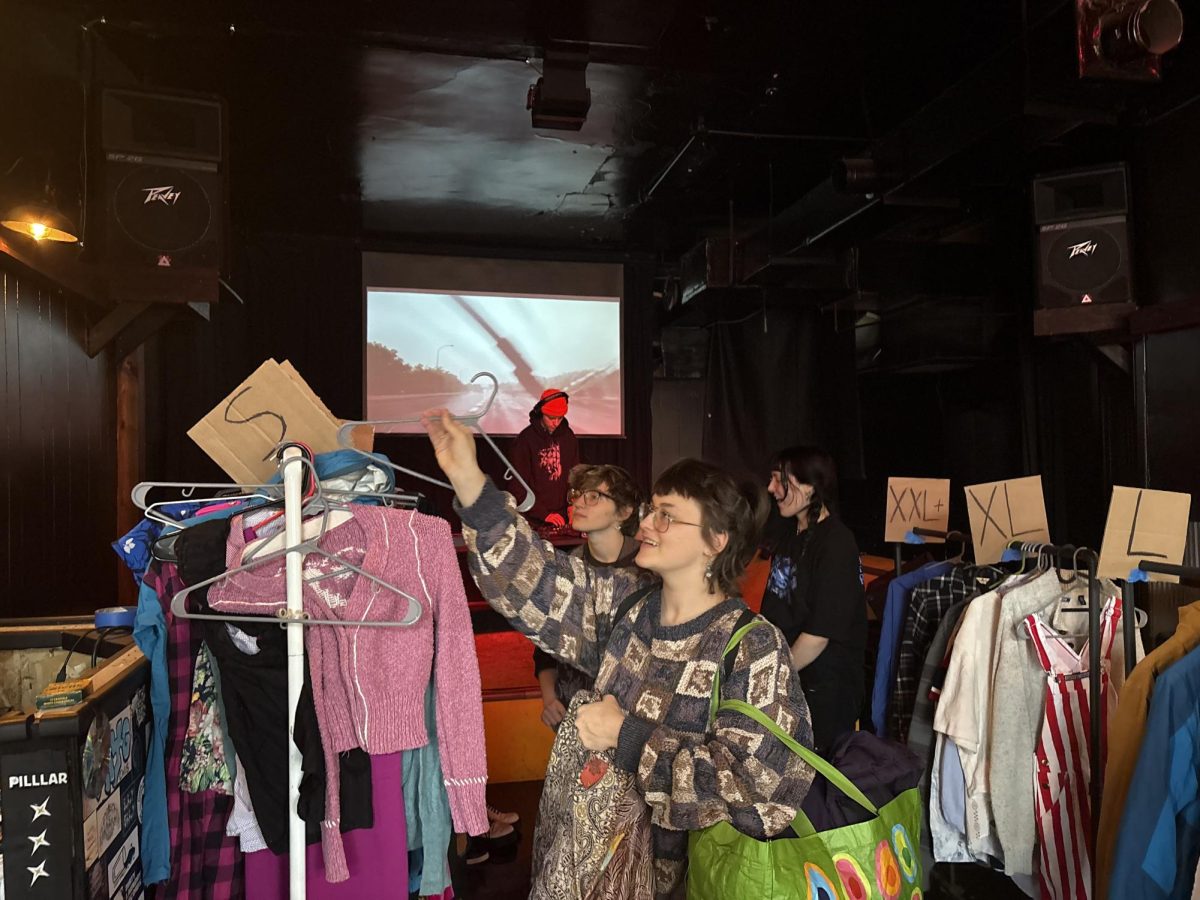Somewhere in 1950s America a switch is thrown: What had been a dark, cavernous room fills with the soft glow of electric light filtered through dozens of colored glass orbs that may once have been fishermen’s floats. As eyes adjust to the sudden illumination, another world is visible. A long bar made of bamboo draws attention to an indoor waterfall. The sound of gurgling water joins recorded calls of tropical birds. As our gaze passes over potted palms and hanging fish traps, driftwood and black velvet paintings, it comes to rest on a curious form.
Huge eyes stare from a huge head. The mouth is twisted into a toothy grimace. The nostrils flare. The chin juts proudly.
Who is this deity that commands so opulent a temple?
He is Tiki.
Tiki culture is an American invention. A pastiche of appropriated images and imagined rituals that rose to prominence in the 1950s as a hedonistic outlet for the Organization Man’s orgiastic fantasies. Although there is no exact definition, tiki culture broadly encompasses tiki bars, tiki mugs, tiki carvings, tropical drinks, musical exotica and various kitsch objects with a Polynesian theme.
The mainstream embrace of tiki culture roughly stretched from the early 1950s to the early 1970s: the entertainment heyday of the Baby Boom generation’s parents.
At its height, the American obsession with tiki produced not only hundreds of tiki bars, but also hotels, apartment buildings, bowling alleys, Laundromats and a host of other businesses which sported a Hawaiian or Polynesian theme and tiki statuary. A range of tiki products as diverse as soap-on-a-rope and a “Tiki-bachi” home grill were produced. Thousands of tiki mugs were created, with design influences that ranged from fairly faithful representations of gods like the Maori Tiki, the Hawaiian Ku and the Moai of Rapa-Nui (Easter Island) to vaguely Polynesian effigies that had more in common with Walt Disney’s cartoons than they did with actual idols.
This gaudy effervescence was doomed to fade however, as tastes changed and the target market aged. By the mid-1980s, only a small remnant of tiki culture’s former glory remained. Sven Kirsten, author of the bible of the current tiki revival, “The Book of Tiki,” credits a few southern California artists and musicians with keeping the tiki torch burning during the dismal Reagan years.
Kirsten styles himself an “urban archaeologist.” German by birth, he came to California at the end of the 1970s to study and work in the film industry. At some point in the late 1980s, he encountered his first images of middle-class Americans enjoying tiki culture. His interest piqued, a tiki mug collecting habit soon followed, and from there he began to investigate surviving tiki bars whose names and locations were often inscribed on the mugs.
Sadly, many of the tiki bars whose mugs were selling for 50 cents in Los Angeles thrift stores had succumbed to the ravages of fate. Kirsten was inspired to document what remained so that a few vestiges of this once-mighty trend might be preserved.
In 1991 at an event sponsored by the dada-influenced pranksters of the Los Angeles Cacophony Society, Kirsten realized his casual research into tiki culture had furnished him with more background information about tikis than anyone else he knew. By the early 1990s, Kirsten, Tiki News editor Otto Von Stroheim and others were holding regular gatherings in Los Angeles – mug parties and slideshows that created a nucleus of tikiphiles around which a scene could accrete.
Since then, the tiki subculture has grown quickly and in many different directions. Of course, like many other subcultures that were once the sole province of a few isolated bohemians, tiki culture has benefited greatly from its exposure to the World Wide Web. Web sites like www.tikiroom.com and www.tyridium.net (Tiki Central and the Tiki Bar Review Pages respectively) have connected far-flung tikiphiles and spurred a major growth in the subculture over the past several years.
This resurgence has not gone unnoticed in the broader culture. A pop housewares firm called Design Toscano, whose products are familiar to anyone who’s been forced to idly leaf through a “Sky Mall” catalogue as their ears pop, has offered several tiki lawn ornaments during the past year. The new film “A Guy Thing” features “tiki girls” (i.e. white bachelor-party hula dancers), much to the horror of tiki aficionados. “There’s no such thing as a ‘tiki girl,'” scoffs Kirsten. He insists that the best way to distinguish faithful from nonfaithful iterations of tiki culture is simple: “If it says ‘tiki’ on it, there should be tiki in it.” Jane Murray, a tikiphile from Toronto, also bemoans the watering down of the culture. “I see it becoming oversaturated in the media,” she says. “And what’s even more unfortunate is this interest in the mainstream media has come too late to save the tiki bars that have had to close due to lack of interest.”
However, there are positive aspects to having a higher profile in the global media sphere. The market in tiki artifacts, which were once found only in a few restaurant supply catalogs and the bric-a-brac section of thrift stores, has expanded to include dozens of online retailers, eBay auctioneers, and a half dozen producers of new original mugs and statuary. Building a decent collection of tiki-phernalia used to take years of diligent sorting through grimy coffee-cups at the local thrift store. Now, in addition to the online sellers, hip lifestyle boutiques regularly carry mugs, statues, stickers and art related to tiki.
What is the essence of tiki culture? For Kirsten, it is the image of a tiki, although he is adamant about drawing a distinction between the actual Pacific religions from which the original images were appropriated and the 1950s American pop culture phenomenon. Others take a broader view.
Murray includes “beachcomber” accoutrements such as glass fishing floats and seashells as authentic tiki décor. Virtually all tiki enthusiasts are quick to decry the creeping degradation of tiki culture by people who believe that Jimmy Buffet and his margarita-drenched pan-tropicalism is appropriate in a tiki context.
Tiki connections in the Twin Cities are difficult to trace. There is no extant tiki bar here, although Nye’s Polonaise preserves a late-1950s lounge feel and the Red Dragon serves a few tropical drinks in an otherwise non-tiki space. Local raconteur and entertainer King Kini hosted a popular club night called Club Velvet from 1995 to 2000 at various locations in Minneapolis. While Kini continues to makes sporadic appearances, with the end of Club Velvet came the end of any organized tiki culture in the area. Bloomington’s Tiki Apartments, near the Mall of America, would appear to be the only tiki-identified business in the Twin Cities.
Asked to comment on the future of tiki culture, Kini’s opinions diverged from Murray’s. According to Kini, “the appeal of this current retro-tiki craze has already peaked, dropped and leveled off, and I imagine it will coast along in the underground just as any other retro pop culture resurgence has.” Kirsten was optimistic about the prospect of an expanded tiki culture, despite the annoyance factor associated with mainstream success. He cites press coverage over the last several years as evidence for a continued “slow growth” in the culture. In addition to a forthcoming smaller version of “The Book of Tiki,” Kirsten plans works on Witco (a tiki-oriented furniture line from the 1960s and 1970s) and Hawaiian shirts of the same period. Whether the current mania for tiki will continue or whether it will be dissipated by the next big craze is of course, not terribly important to the true tikiphile. Owning the mugs and art, listening to the music, drinking the cocktails, finding others who share your passion – these are the ways in which tiki devotees venerate their idol.







